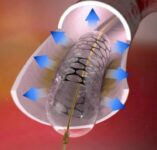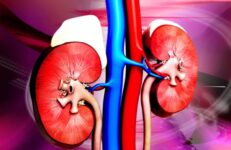Original title: Effect of high-intensity statin therapy on atherosclerosis in non-infarct-related coronary arteries (IBIS-4): a serial intravascular ultrasonography study. Reference: Räber L et al. Eur Heart J. 2015 Feb 21;36(8):490-500. The long-term effect of intensive statin therapy on coronary atherosclerosis in patients admitted pursuing an ST segment elevation myocardial infarction is unknown. The aim of this study was…
Partial occlusion of coronary sinus reduces refractory angina
Original title: Efficacy of a Device to Narrow the Coronary Sinus in Refractory Angina. Reference: Verheye S et al. N Engl J Med 2015 Feb 5;372(6):519-27. The number of patients with severe diffuse coronary artery disease who are not candidates for revascularization is growing in Western countries, generating multiple procedures and increasing healthcare expenditure. New and unconventional solutions…
Zotarolimus eluting stent with one month of dual antiplatelet therapy
Original title: Zotarolimus-Eluting Versus Bare-Metal Stents in Uncertain Drug-Eluting Stent Candidates. Reference: Marco Valgimigli et al. J Am Coll Cardiol. 2015;65(8):805-815. The use of drug eluting stents (DES) in patients at high risk of bleeding or thrombosis has not been studied prospectively. Data on patients at high risk of bleeding and low restenosis are limited. This study compared…
Invasive evaluation of patients with angina in the absence of coronary lesions
Original title: Invasive Evaluation of Patients with Angina in the Absence of Obstructive Coronary Artery Disease. Reference: Bong-Ki Lee et al.Circulation published online before print February 20, 2015. More than 20% of patients presenting to the cath lab with angina symptoms have no angiographic evidence of coronary artery disease (CAD). Despite a “normal” angiogram, these patients have persistent…
The MGuard stent shows a trend toward reduced mortality in PCI
Original title: Mesh-Covered Embolic Protection Stent Implantation in ST-Segment–Elevation Myocardial Infarction. Final 1-Year Clinical and Angiographic Results From the MGUARD for Acute ST Elevation Reperfusion Trial. Reference: DariuszDudek et al. CircCardiovascInterv. 2015 Feb;8(2). The MGuard is a micronet mesh-covered stent designed to reduce distal embolization in the context of ST elevation myocardial infarction. In the MASTER study…
The poor prognosis of critical limb ischemia related to sub treatment
Original title: Peripheral arterial disease and critical limb ischaemia: still poor outcomes and lack of guideline adherence. Reference: Reinecke H et al. Eur Heart J. 2015; Epub ahead of print. This work included 41882 patients retrospectively from health insurance in Germany admitted with diagnosis of peripheral vascular disease between 2009 and 2011 and followed until 2013. Patients…
Impact of kidney function on TAVI outcome
Original title: Impact of chronic kidney disease on the outcome of transcatheter aortic valve implantation: results from the FRANCE 2 Registry. Reference: Atsushi Oguri, et al. EuroIntervention 2015;10:e1-9 Globally, 13% of patients present kidney failure, which has been associated to a worse evolution not only of TAVI outcomes but also of other cardiovascular intervention outcomes. Most studies, including…
Bioabsorbable stents also in peripheral territory
Original title: Evaluation of the Biodegradable Peripheral Igaki-Tamai Stent in the Treatmentof De Novo Lesions in the Superficial Femoral Artery. The GAIA Study. Reference: Martin Werner et al. J Am Coll Cardiol Intv 2014;7:305–12. The aim of this study was to assess the safety and efficacy of the biodegradable stent Igaki-Tamai (Igaki Medical Planning Company, Kyoto, Japan) in…
Linear relationship between prognosis and FFR value
Original title: Prognostic Value of Fractional Flow Reserve Linking Physiologic Severity to Clinical Outcomes. Reference: Nils P. Johnson et al. J Am Coll Cardiol 2014;64:1641–54. Fractional flow reserve (FFR) has become an essential tool for guiding treatment, but its graded relationship to prognosis and its influence by medical treatment vs revascularization, remains unclear. The hypothesis of this study…
Different characteristics of non culprit plaque by OCT
Original title: Pancoronary plaque vulnerability in patients with acute coronary syndrome and ruptured culprit plaque: A 3-vessel optical coherence tomography study. Reference: Rocco Vergallo et al. Am Heart J 2014;167:59-67. Recent studies have described different clinical characteristics between ACS patients with and without ruptured culprit plaque. Given the systemic nature of atherosclerosis, the hypothesis of this study is…
Positive result of intraarterial thrombolysis in acute ischemic stroke
Original title: A Randomized Trial of Intraarterial Treatment for Acute Ischemic Stroke. MR CLEAN Investigators. Reference: O.A. Berkhemer et al. N Engl J Med 2015;372:11-20. In patients undergoing acute ischemic stroke caused by a proximal intracranial artery occlusion, intraarterial endovascular treatment is effective; however, there is no evidence of clinical or functional benefits. This study randomized patients undergoing…










